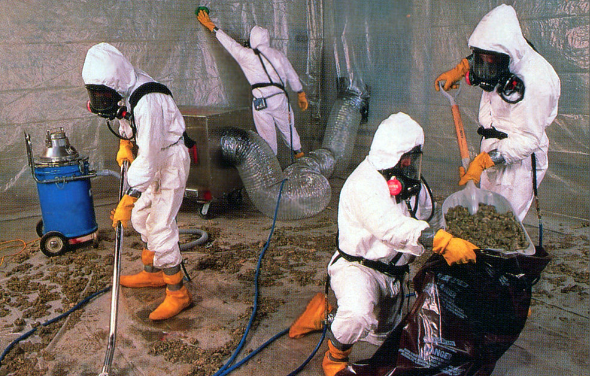The Department of Environmental Health and Safety (EHS) are responsible for administrative decisions regarding asbestos control and abatement at the University of Vermont. All activities involving asbestos require prior approval from EHS Environmental Compliance and Safety Office.
EHS provides consultative and technical assistance to campus groups involved in asbestos related activities. EHS serves as the University's liaison with regulatory agencies and serves as the clearing house for the dissemination of regulatory and University requirements and new information to the groups in asbestos related activites.
Written Program
Regulatory Requirements
Additional Information Resources
Frequently Asked Questions
What is asbestos?
Asbestos is a naturally occurring mineral that is usually excavated from open-pit mines. The asbestos rock is then crushed to free the fibers. Asbestos is mixed with a material that binds the fibers together so they can be used in many different products. The three most common types of asbestos found in today’s industrial applications include:
- Chrysotile – The most often used asbestos, it is highly resistant to heat and can be easily spun into asbestos cloth.
- Amosite – Commonly referred to as brown asbestos, amosite is highly resistant to heat and acid. It has been used mainly in bulk form for heat insulation and molded into pipe insulation.
- Crocidolite – Highly resistant to acid, it is used to make electric battery cases and acid-resistant cement pipes. Crocidilite is also commonly referred to as blue asbestos.
Even if asbestos is in your building, it is usually NOT a serious problem. Most people exposed to small amounts of asbestos, as we all are in our daily lives, do not develop health problems. The mere presence of asbestos in a home or building is not automatically a hazard. The danger is that asbestos materials may become damaged overtime.
The best thing to do with Asbestos Material in good condition is to leave it alone. Not all types of building materials at the University have been assessed for the presence as asbestos. Materials must be presumed as asbestos-containing unless proven otherwise. Common locations and uses for asbestos in public and commercial buildings include the following:
- Some vinyl floor tiles to strengthen them and on the backing of some vinyl floor sheeting
- Patching compounds manufactured before 1977 used to patch walls and ceiling joints
- Wall and ceiling insulation
- Fluffy, friable asbestos sprayed on ceiling tiles for fire-proofing protection
- Sprayed or troweled onto ceilings or walls as an acoustical or decorative treatment
- Insulation around pipes, heating ducts, furnaces and boilers
- Some roofing shingles, siding shingles and sheets have been manufactured with asbestos
- Sprayed in steel reinforcing beams as fire-proofing
- Brake lining and clutch pads
What are the health risks of exposure to asbestos?
It is generally accepted that exposure to airborne asbestos fibers increases the risk of developing health effects — such as lung cancer, mesothelioma and asbestosis. Factors that play a part in determining the relative risk of disease include:
- How much asbestos, and of what type, is in the air,
- How often and for how long exposure to airborne fibers occurs,
- How much time has passed since exposure to airborne fibers began,
- Whether the person already has lung or breathing conditions, and
- Whether the person smokes tobacco.
Nationally, exposure potential for general building occupants appears to be low; therefore the risk of developing asbestos related disease is low.
The Centers for Disease Control provide a lot of useful information at www.atsdr.cdc.gov/asbestos/index.html
Is there asbestos at UVM?
Yes and the University of Vermont is not unique in this. Products containing asbestos are found throughout the construction industry, so do exist in University buildings. UVM tests materials in buildings and rooms across campus and has done so for over 30 years. Records of those tests are maintained by EHS and may be used when determining risks when planning renovation and maintenance activities. Materials that have not been tested are Presumed Asbestos Containing Materials (PACM).
To avoid disturbance of unknown asbestos containing materials, the EPA has mandated that areas that are to be renovated or demolished must first be surveyed for asbestos containing materials. Positive results require that the plan be revised to avoid disturbing the material, or that an asbestos abatement activity be conducted. Individuals trained and certified in the discipline must perform surveys.
UVM EHS and Facilities Management ensure that asbestos containing materials are maintained so that asbestos fibers are not released into the air where they become a respiratory hazard. Abatement activities are implemented if materials are found to be at risk for releasing the fibers into the air.
When is asbestos removed at UVM?
Removal of asbestos containing materials is not undertaken if they are in good condition and have little potential for disturbance by maintenance, renovation and daily activity. When asbestos containing materials will be disturbed by renovation, demolition, or are badly deteriorated such that they can not be repaired, they are abated. Asbestos containing materials that present minimal exposure potentials and are performing their function are maintained.
What is an asbestos abatement activity?
An asbestos abatement activity is the repair, enclosure, removal, encapsulation, maintaince or any other activity (project design, monitoring, planning, inspecting) for the evaluation or control of any material which contains more than one percent asbestos.
Page Last Updated: February 23, 2024

